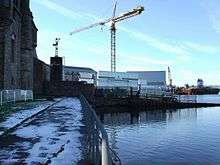Ferguson Marine Engineering
 | |
| Private | |
| Industry | Shipbuilding |
| Founded | 1903 |
| Headquarters | Port Glasgow, Inverclyde, Scotland |
Key people |
JimMcColl, (Chairman) Gerry Marshall (Chief Executive) |
Number of employees | Over 350 |
| Parent |
Lithgows (1961-1970) Scott Lithgow (1970-1977) British Shipbuilders (1977-1989) Clyde Blowers Capital (2014-present) |
| Website |
www |
Ferguson Marine Engineering Ltd is a shipyard located in Port Glasgow on the River Clyde in Scotland. It is the last remaining shipbuilder on the lower Clyde, and is currently the only builder of merchant ships on the river - the company's mainstay has long been Roll-on/roll-off ferries, primarily for Caledonian MacBrayne, the largest of which will operate betwwen Ardrossan and Isle of Arran, the MV Glen Sannox, which is also Ferguson's largest product ever built. Ferguson's also built three of the world's first roll-on/roll-off Hybrid powered Car ferries MV Catriona, MV Hallaig and MV Lochinvar. Ferguson's has built over 360 ships.
On Friday 15 August 2014, the shipyard appointed KPMG as administrators, placing the company into administration.
Wednesday 10 September 2014 saw Clyde Blowers Capital, an industrial company owned by Jim McColl, purchase the yard for £600,000.[1] Clyde Blowers Capital have invested just over £25 million in the shipyard and have increased to workforce to a core of just over 200 employees as of 2018 has 350 employees .
History

The company was founded by the four Ferguson Brothers (Peter, Daniel, Louis and Robert) who left the Fleming & Ferguson shipyard in Paisley to lease the Newark yard in Port Glasgow in March 1903.[2] The Ferguson brothers acquired the freehold in the Newark yard in 1907. The company was purchased by John Slater Ltd (Amalgamated Industries) in 1918, but returned to control of the Ferguson family in the late 1920s. Lithgows Ltd purchased an interest in the business in 1955 after Bobby Ferguson's death[2] and took control of the Company in 1961. The company remained a separate entity within the Scott Lithgow group from 1969 to 1977.[2]
The company was nationalised and subsumed into British Shipbuilders in 1977. The business was merged with the Ailsa Shipbuilding Company to form Ferguson-Ailsa Ltd in 1980.[2] Ferguson and Ailsa were separated again in 1986 and Ferguson merged with Appledore Shipbuilders in Devon to form Appledore Ferguson. By the late 1980s the only yards still held in state ownership were the smaller Appledore and Ferguson yards.[3] Ferguson was demerged from Appledore and acquired by Greenock-based engineering firm Clark Kincaid in 1989 and started trading as Ferguson Shipbuilders.[2] Clark Kincaid itself was acquired by Kvaerner and became Kvaerner Kincaid in 1990.
Ferguson Shipbuilders Ltd was sold by Kvaerner to Ferguson Marine plc in 1991. The entire shareholding in Ferguson Marine was acquired by the Holland House Electrical Group in 1995.[4] Former owner Kvaerner Kincaid was sold to Scandiaverken in 1999 and later ceased manufacturing at its Cartsburn site in Greenock during 2000.
In September 2014, following the acquisition by Clyde Blowers Capital, the company was renamed Ferguson Marine Engineering Ltd.
On 21 November 2017, the yard launched the UK's first dual-fuel ferry, MV Glen Sannox.
Yard numbers
The Company applied yard numbers which started from the end of the sequence used by Fleming & Ferguson from 1902. It then used yard numbers which started from the end of the sequence used by the Ailsa Yard from 1985.
References
| Wikimedia Commons has media related to Fergusons Shipyard. |
- ↑ "Ferguson Shipbuilders sold to Clyde Blowers Capital". Retrieved 10 September 2014.
- 1 2 3 4 5 Goodwin, Karin (5 March 2007). "History of a shipbuilding family". BBC News.
- ↑ Bowen, David (4 September 1994). "Britain misses the boat: After years in the doldrums, there are new opportunities for the shipbuilding industry worldwide, but the once-great yards of Britain may now be too weak to take advantage". The Independent. London.
- ↑ "The last family run shipyard", Clydesite Magazine, 2005 .
